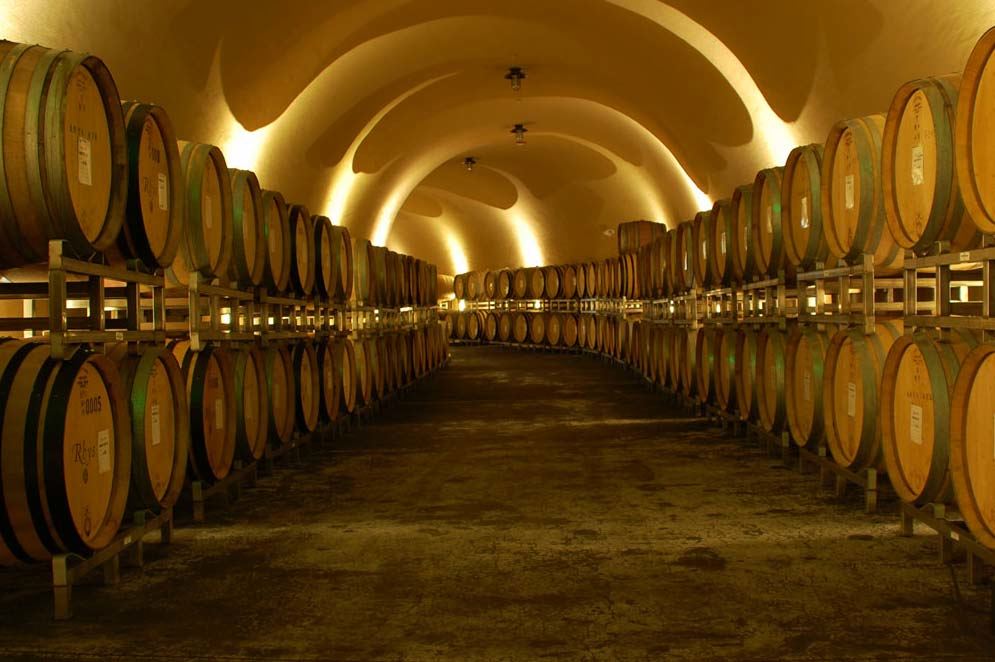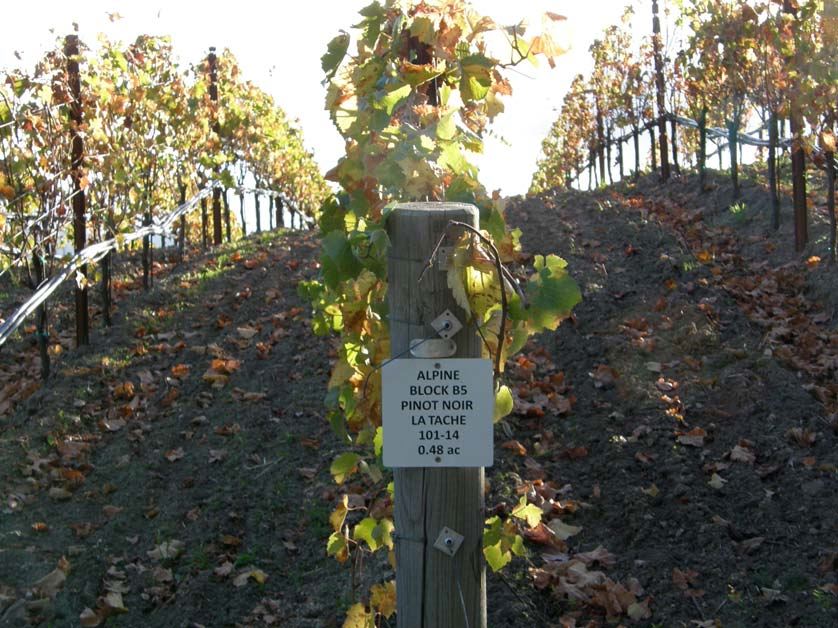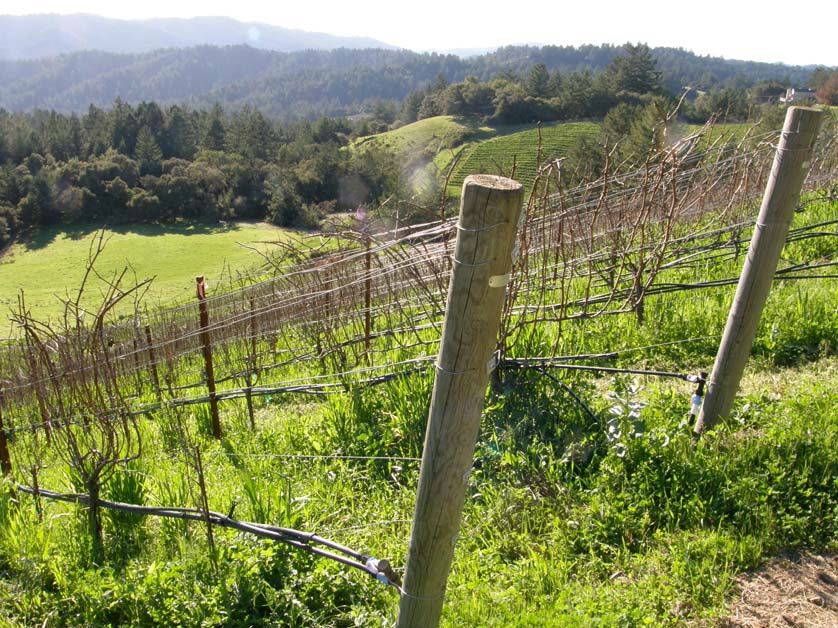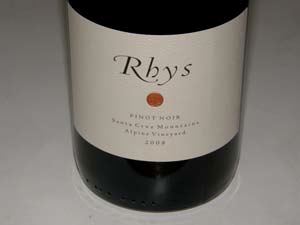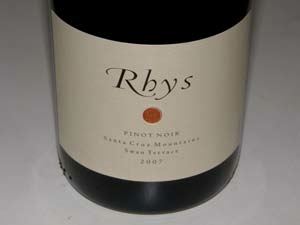Rhys Vineyards: Tasting Recent Vintages is a Revelation
The number of wineries in the Santa Cruz Mountains is relatively small for such a large appellation, but the
Pinot Noirs of a few producers are among the best in California. These wineries include Big Basin Vineyards,
Mount Eden Vineyards, Rhys Vineyards, Thomas Fogarty, Varner and Neely, and Windy Oaks Estate
Vineyards & Winery among those whose wines I have sampled recently.
Owner Kevin Harvey of Rhys Vineyards currently has five diverse vineyards with distinct geological profiles in
the Santa Cruz Mountains. Two of them, Family Farm Vineyard and Home Vineyard, are technically just
outside the AVA but produce wines that are Santa Cruz Mountains in character. The other three vineyards are
Alpine, Horseshoe Ranch, and Skyline. Most recently, Harvey has acquired an abandoned apple orchard on
the southern end of the Santa Cruz Mountains chain near Corralitos where he plans to plant an additional 20
acres in 2013. Still another estate vineyard, Bearwallow, is located in the deep end of the Anderson Valley.
The vineyards are described in detail on the winery’s website at www.rhysvineyards.com.
All the vineyards meet important criteria: shallow soils which limit vigor, iron-rich soils, deeply fractured and
rocky subsoils which allow vine roots to penetrate deeply, moderate clay content and limited water holding
capacity, steep non-forested slopes, and a cool climate. Yields from these vineyards have typically been
painfully low.
The name, Rhys, is derived from the Welsh spelling of Reese. The first estate vineyard Pinot Noir release
came in 2004, and the 2007 vintage was the first in which all five vineyards were in production. A second
bottling from Alpine Vineyard is from a special block known as Swan Terrace, and is kept separate because of
its distinctive character.
Harvey has shunned the newer Dijon clones for the most part and instead planted “suitcase” selections such
as Calera, Swan, La Tache, Hyde and Wente. Over time, vines have been identified that naturally produce
optimal quality at each of the vineyard sites. These vines offer a perfect balance of crop and canopy without
excessive management and the wines that are produced from these vines have been carefully scrutinized. In
some instances, the Rhys crew has determined that they then can achieve higher quality by regrafting some
vines with cuttings from existing vines. The majority of the new grafts are a selection massale (mass selection)
or mixture of clones that have been find optimal for a given vineyard. This is an extensive undertaking, but one
that will steadily increase quality in the future.
The young and talented winemaker at Rhys Vineyards is Jeff Brinkman. Brinkman majored in biochemistry in
college, sold wine at the retail level for a short time, and then learned winemaking on the job, beginning as a
cellar rat in 1996. Brinkman makes it clear that Rhys wines are made in the vineyard.
In the winery, the grapes from each site are handled in an identical manner. Picking occurs early, often at 21.5º
to 23º Brix. The grapes are harvested over a several day interval without concern about achieving the same
ripeness in every vine row. Harvey notes, “A variety of ripeness makes a more interesting wine.” The grapes
are carefully hand sorted, and placed 100% whole cluster into 1-ton fermentation tanks. Fermentations are
carried out in small lots from specific vineyard blocks and reassembled in the blending process later. A 10 to
14-day cold soak under sealed conditions is followed by natural fermentation. The cap is punched down three
times a day by foot treading. The wine is pressed off with a basket press and the juice gravity fed into oak
barrels. Blending takes place either before or after the next harvest after the wine spends approximately 14
months in barrel. All barrels are sourced from Francois Frères and made from 4-year air-dried staves,
eliminating any barrel variability effect on the finished wines. New oak percentage is variable and constantly
being refined. The estate wines are unfined and unfiltered. The whole winemaking process is natural and
straight forward and harkens back to the days in Burgundy when wine really was made in the vineyard.
Rhys wines are highly allocated and sold only through a mailing list. Allocations are based on aggregate
purchase history. The wines are very hard to come by and I often don’t receive a full allocation of every wine.
The wines are released to mailing list customers in the spring and fall. Most wines are aged a full year in bottle
before release. Rhys Chardonnays are exceptional as well. A second label, Alesia, offers less-expensive
wines from regions outside the Santa Cruz Mountains and wines that do not fit into vineyard-designated
bottlings.
A 10,000-case winery ensconced in a cave at Skyline Vineyard was finished in 2010 and has hosted Open
Houses for members of the mailing list on Pickup Days. Allen Meadows, Eric Asimov, Matt Kramer and many
others, including myself, have been fans of these terroir-driven wines. Follow Rhys harvest and happenings at
www.twitter.com/RhysVineyards. For the complete low down on Rhys Vineyards, read my feature from 2009 at
www.princeofpinot.com/article/633/.
I recently got the urge to pop some corks on recent vintages of Rhys Vineyards Pinot Noirs to see how the
wines were progressing. Most of my tastings have been at the winery with barrel samples or recently bottled
examples. This tasting was a revelation. The wines are low in alcohol, yet exhibit ripe fruit phenolics. They
are all deeply colored with no intrusion of oak and nicely integrated acidity. All the wines change dramatically
over time in the glass, and some have very impressive length. These are serious wines that benefit from
cellaring and will continue to evolve over the coming years. It will be exciting to see what these wines are like
ten years down the road compared to their Burgundy cousins. I suspect the fruit will fade and exhibit
secondary characters, the now prominent tannins (of the 2007 and 2008 vintages) will change and integrate,
while the bright acidity will hold the wines together, and the low alcohol levels should never intrude.
2009 Rhys Santa Cruz Mountains Pinot Noir
13.3% alc., $45. The inaugural Santa Cruz Mountain
appellation Pinot Noir is a blend of barrels from Alpine and Horseshoe vineyards. As the vineyards mature and
produce more wine with each vintage, more careful barrel selection is done to determine the final single
vineyard wines, making this appellation bottling available.
·
Medium reddish-purple color in the glass. Outgoing
aromas of dark berries, spice, redwood and campfire. Deliciously rich and intensely flavored core of black
cherry, dark berry and blueberry fruits, exotically spiced with a hint of lemongrass. Very soft and easy to drink
now. Less refined the following day from a previously opened and re-corked bottle, showing more oak. This is
a solid daily drinker for current consumption. Good.

2008 Rhys Alpine Vineyard Santa Cruz Mountains Pinot Noir
13.3%
alc., $59.
·
Moderately dark reddish-purple color in the glass. The
aromas are clean and airy, smelling of a vast meadow of damp earth and
brush, but also endowed with scents of ripe dark cherries and black
raspberry syrup. I find this nose enchanting. On the palate, the wine
offers a dark red fruit festival with a hint of baking spices showing more
body, more finish and better integrated tannins than the 2007 vintage
version. Very flavorful now but still young at heart.
2007 Rhys Alpine Vineyard Santa Cruz Mountains Pinot Noir
13.3% alc., $49.
·
Moderately dark reddish-purple
color in the glass. Wonderful nose replete with bright aromas of black cherries, cherry pie, spice,
vanilla, pipe smoke and an earthy goodness. Moderately rich basket of fresh black cherries wrapped in firm,
slightly astringent tannins, filling the palate with flavor, finishing long and very dry. Much more interesting and
expressive the following day from a previously opened and re-corked bottle. Patience will be rewarded.
Very good (+).
2008 Rhys Alpine Vineyard Swan Terrace Santa Cruz Mountains Pinot Noir
13.0% alc., $59.
·
Medium
reddish-purple color in the glass. Shy aromas of darker berries, briar and dark chocolate. Fresh, juicy and
modestly rich, offering flavors of mixed blue and black berries backed by ripe, firm tannins. Still young, and a
bit monotone now, the wine opens slowly and reluctantly in the glass. The finish, even now, is notable for its
staying power. Slightly better the following day from a previously opened and re-corked bottle, showing a
lighter character and more acidity than the 2007 vintage version. Very good.

2007 Rhys Alpine Vineyard Swan Terrace Santa Cruz Mountains Pinot Noir
13.5% alc., $59. From a 1.5-acre section of Alpine Vineyard
planted to a Swan field blend.
·
Moderately dark reddish-purple color in
the glass. Another aromatic wonderland with scents of berry jam, spice,
and an exotic floral note. Better and better over time in the glass.
Would love to make a perfume like this. Amazingly fresh flavors of
alpine strawberries with an interesting candied and edible flower note. I
have never tasted anything quite like this in a California Pinot Noir. The wine
displays healthy tannins, but they are better integrated in this wine and nicely
balanced by the lively acidity. Filled with verve and intrigue, this is a wine to
savor. Flat-out great the following day from a previously opened and re-corked bottle.
2008 Rhys Skyline Vineyard Santa Cruz Mountains Pinot Noir
12.2% alc., $69.
·
Moderately dark reddishpurple
color in the glass. The nose is attention-getting with deep aromas of blackberries, sassafras, spice and
old oak building in intensity over time in the glass. Blackberry and black plum flavors have interest but the wine
is a bit tedious . Nicely crafted with notable but not intrusive tannins and the slightest oak in the background,
but not enough Pinot singing on the finish. Slightly more expressive black fruits the following day from a
previously opened and re-corked bottle. Check back in a few years. Good.
2007 Rhys Family Farm Vineyard San Mateo County Pinot Noir
13.4% alc., $49.
·
Moderately dark reddishpurple
color in the glass. Shy aromas of dark cherries and berries with notes of oak char and anise. The nose
never really opens until the following day. Lavish core of dark berry, black currant and black plum flavors with
impressive density and lip-smacking sappiness. The wine has a very seamless quality and finishes on a high
note with delicious tannin-backed dark raspberry flavor. Equally fine the following day from a previously
opened and re-corked bottle. Very good (+).
